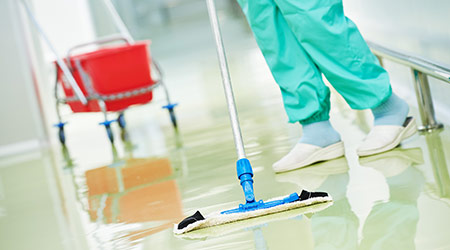According to the 2017 Leapfrog Group Hospital Survey, each day about one in 25 U.S. hospital patients contracts an HAI. These infections can significantly delay recovery, increase the cost of a hospital stay, and potentially result in death. The direct cost of HAIs to hospitals is estimated to be between $28 billion and $45 billion.
With that much at stake, healthcare facilities are tasked with sorting through a variety of products and devices on the market that promise to safely clean and disinfect furniture, equipment and rooms. They also are looking at how to balance infection control with green – or sustainable – cleaning efforts.
Patrick Kehoe, a product marketer for cleaners and disinfectants for Minnesota-based 3M Company, said when it comes down to infection control, guidance on what to use always begins with risk assessment – what is going on in a facility, and what products will help it achieve its goals while mitigating and reducing the risk of cross contamination and further infections?
Cleaning/chemical solutions
Common healthcare pathogens like Clostridium difficile (C. diff) and methicillin-resistant Staphylococcus aureus (MRSA) can survive on surfaces for extended time periods and contribute to the ongoing risk of contamination and infection.
When it comes to cleaners and disinfectants, it’s been said that healthcare doesn’t care about green cleaning, but painting an entire industry with such a broad brush is not accurate. Instead of focusing on green cleaning and products, Kehoe said 3M – and many other companies – focus on sustainability.
“We define it as environmentally preferable products, made with green ingredients and Green Seal-approved,” Kehoe said. “We say sustainability is OK, but you also have to look at safety, reducing exposure and reducing chemical usage.”
3M’s approach focuses on “doing it right the first time” to save time and money.
3M’s Twist ‘n Fill System Dispenser takes direct aim at the budget by diluting chemical concentrates with water to create ready-to-use cleaning products. The company’s Flow Control System then takes those products and accurately measures and combines disinfectant mixtures to better kill germs, and reduce the risk of cross contamination and HAIs.
“Inaccurate dispensers might have too much or not enough of a chemical, and those cause issues. If there is not enough, you’re not meeting your kill claims. If there is too much, you are potentially increasing exposure to users and wasting chemical,” Kehoe said. “At the end of the day, it comes down to the tech data sheet and what claims do disinfectants have; and how do you do the best job the right way one time rather than using nichey products more than you need to.”
When it comes to sustainability, Ecolab takes a holistic and total impact approach, including considerations of water, energy, waste, user safety and product sustainability attributes. The company looks at biodegradability and toxicity to aquatic life, among other metrics, to define the environmental impact of products. Innovations in this area include solutions that do not require special protective equipment and/or packaging and dispensing systems. this allows concentrated products to be shipped and automatically diluted on site with closed loop packaging to protect the user from handling concentrated chemicals.
In response to the challenge of C. diff, Ecolab developed OxyCide Daily Disinfectant Cleaner - an EPA-registered sporicide that breaks down to vinegar and water after use. OxyCide is a concentrated product, reducing packaging waste, and is dispensed through a close-loop system that minimizes worker exposure to concentrated product. When properly diluted, it requires no personal protective equipment for use.
Ecolab also has a 3-in-1 multi-surface spray disinfectant - Peroxide Multi-Surface Cleaner & Disinfectant - that siinfects in three minutes, providing a kill time of 45 seconds for Norovirus. Similar to OxyCide, this disinfectant is a concentrated product, reducing package waste, and requiring no personal protective equipment when properly diluted.
Clorox Healthcare similarly adopts the motto “green where you can and disinfect where you must.”
Clorox Healthcare claims its Fuzion Cleaner Disinfectant is a bleach – long recognized as one of the most effective strategies in reducing C. diff – that has a low-residue formula that kills C. diff spores in two minutes, and 35 other pathogens – including bacteria, viruses and fungi – in one minute.
Larinda Becker of South Carolina-based Diversey Inc., said when it comes to cleaning and disinfection solutions, it is paramount to have clearly defined roles and responsibilities for staff members. This is followed in importance by ensuring staff can execute their jobs with the proper products, tools and job aids.
“This includes having product and tools that help them get the job done faster, as well as products that are pleasant to use around patients and by staff,” Becker said. “People will more likely use a product if they have a good experience.”
Diversey’s Oxivir disinfectant cleaners – powered by Accelerated Hydrogen Peroxide (AHP) – are touted as effective against bacteria, enveloped and non-enveloped viruses, tuberculosis (TB) and fungi in one minute or less. The active ingredients break down into oxygen and water shortly after use, making it environmentally friendly.
UMF Corporation based in Illinois has evaluated Klorkleen 2 effervescent NaDCC (sodium dichloroisocyanurate) tablets for cleaning and disinfection. The broad-spectrum cleaner and disinfectant, manufactured by Ireland-based Medentech, is registered by the EPA as the first product to be effective against biofilms, which are resistant to disinfectants and result in HAIs. Kill claims include C. diff spores, norovirus, TB and CRE.
UMF CEO George Clarke explains the active ingredient in Klorkleen 2 is hypochlorous acid (HOCl) – basically a disinfectant that mimics the way the human immune system reacts to kill bacteria and inactivate viruses. The bonus, he said, is it has none of the caustic or corrosive effects of bleach, while being four times more powerful than bleach.
“It won’t take the dye out of your Levi’s, drill holes in your pants, take the color out of uniforms,” George said. “On nonporous surfaces it doesn’t have any damaging impact of chlorine or bleach.”
UV disinfection technology
Infection prevention experts agree that thorough cleaning and disinfection is essential to effective infection prevention programs. But Becker points out traditional manual cleaning and disinfection practices in hospitals are often suboptimal.
“Inconsistent manual cleaning processes, time pressure and lack of an auditing process can affect the efficacy of manual disinfection,” Becker said. “Human error will always be part of manual disinfection.”
Enter ultraviolet C (UVC) disinfection technology.
The use of UVC disinfection technology, like the Clorox Healthcare Optimum-UV Enlight System, is billed as optimizing infection prevention against persistent pathogens in high-risk areas. But everyone agrees the adjunct technology is not a replacement for manual surface cleaning and disinfection.
Diversey’s MoonBeam 3 Technology UVC disinfection device has three individually-adjustable arms that can be positioned at almost any angle to target the UVC light to the highest risk surfaces. The bulbs in the system use excited mercury vapor, similar to overhead fluorescent lighting in an office setting, making it recyclable in the same manner as office bulbs.
“Their optimized use of electrical power reduces greenhouse gasses and the pollutants associated with electricity production, and our long bulb life reduces landfill waste,” Becker said.
A UVC device can be a $5,000 to $10,000 or higher capital expense, and facilities typically need to buy more than one. Kehoe said he sees UVC devices predominantly purchased for high turnover rooms and operating rooms, but facilities still go in and clean even after using a UVC device.
“It’s a safeguard. You fry everything and deactivate everything with the light, but you still come in and wipe things down,” Kehoe said. “When a customer is evaluating the different devices vs. disinfectants, you can lead them down the path to understand if you use this device, it still behooves you to wipe things down.”
Hand sanitizers
Another way healthcare facilities fight back against HAIs is the use of hand sanitizers.
Kehoe said hand sanitizers have seen a unique evolution over the years. The bird and swine flus caused a stir five to 10 years ago, which led to an increase in hand sanitizers becoming the number one defense. The push came from studies that found the biggest variable in infection control was not being able to watch everyone wash their hands. Hand sanitizer dispensers at every door were the answer.
Kehoe said hand sanitizers are alcohol based and come in foam or gel form. Foam hand sanitizers contain more air, while the gels are a little thicker and require more water during manufacturing.
“Gel hand sanitizers caused more controversy because they tend to hit the floor quicker. With the foam, you dispense, rub in your hands and there is not a lot of excess,” Kehoe said. “With the gel, you dispense a dollop and have a bunch of gunk on your hands. You shake your hands to get it off. That alcohol-based hand sanitizer finds it ways to floor and eats up the floor finish, requiring stripping and recoating the floors more often.”
Diversey’s IntelliCare commercial hand hygiene system features a hybrid automatic dispenser with both touchless and manual activation, for when battery power is depleted. The system can be used with a variety of hand care formulations, allowing facilities to customize product selection based on environment, site or user needs.
Diversey also has SoftCare ImpactTM/MC alcohol instant hand sanitizer in both liquid and foam. The product is perfume-free and packaging is collapsible for less waste volume, uses less plastic than most and is recyclable.
Options
Clarke said the message is there are good sustainable alternatives out there if healthcare professionals are “willing to open their eyes and take a look.” He said the trend toward sustainability is growing, but at a slow pace.
“I equate it to Chinese water torture – drip, drip, drip,” Clarke said. “In the future there are going to be people who will finally wake up and look at sustainable products as safe to use and don’t have any impact on the human condition, but are also highly effective against organisms really causing the problems.”

 Technology Trends for Healthcare Real Estate in 2025
Technology Trends for Healthcare Real Estate in 2025 Advocate Healthcare Invests $1 Billion Into Chicago's South Side
Advocate Healthcare Invests $1 Billion Into Chicago's South Side Children's Medical Center Plano Opens New Patient Tower
Children's Medical Center Plano Opens New Patient Tower Layered Security on the Rise in Facilities
Layered Security on the Rise in Facilities OhioHealth Plans New Comprehensive Outpatient Cancer Center
OhioHealth Plans New Comprehensive Outpatient Cancer Center